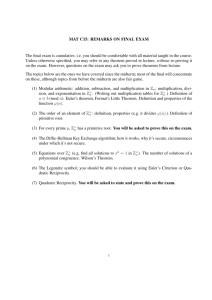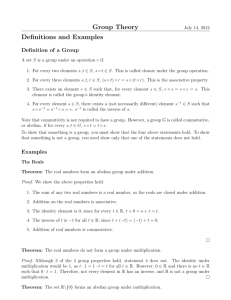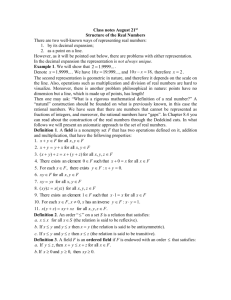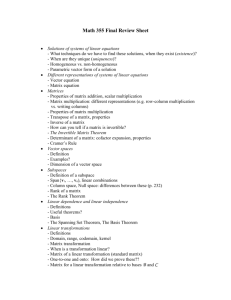notes_2_groups
advertisement
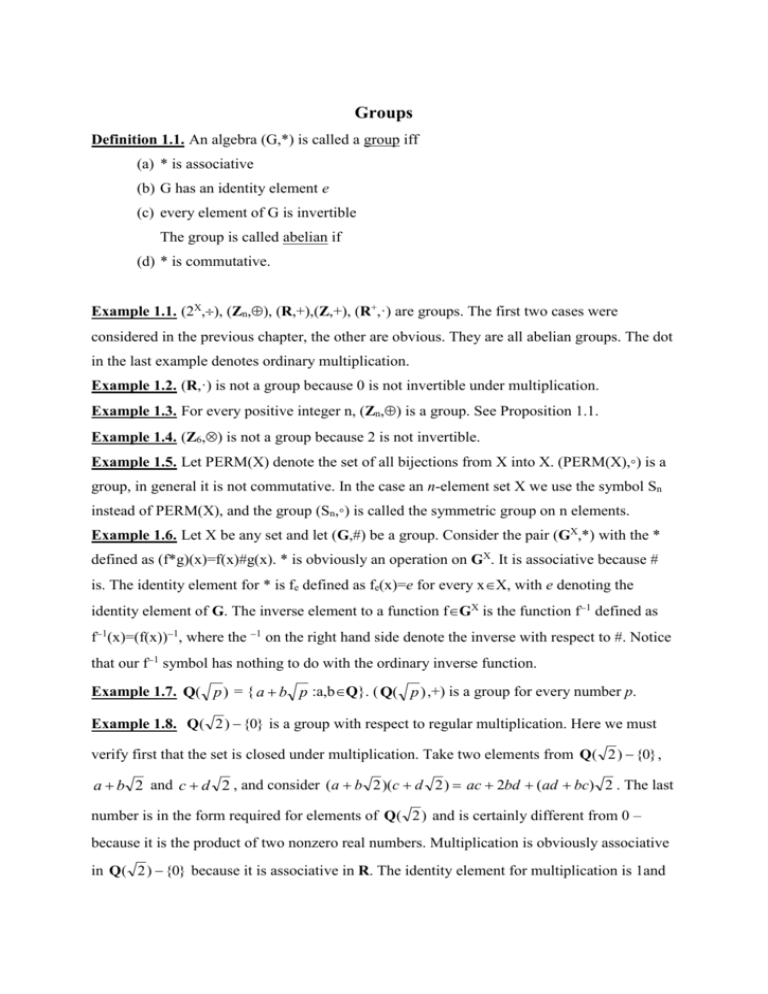
Groups
Definition 1.1. An algebra (G,*) is called a group iff
(a) * is associative
(b) G has an identity element e
(c) every element of G is invertible
The group is called abelian if
(d) * is commutative.
Example 1.1. (2X,), (Zn,), (R,+),(Z,+), (R+,·) are groups. The first two cases were
considered in the previous chapter, the other are obvious. They are all abelian groups. The dot
in the last example denotes ordinary multiplication.
Example 1.2. (R,·) is not a group because 0 is not invertible under multiplication.
Example 1.3. For every positive integer n, (Zn,) is a group. See Proposition 1.1.
Example 1.4. (Z6,) is not a group because 2 is not invertible.
Example 1.5. Let PERM(X) denote the set of all bijections from X into X. (PERM(X),◦) is a
group, in general it is not commutative. In the case an n-element set X we use the symbol Sn
instead of PERM(X), and the group (Sn,◦) is called the symmetric group on n elements.
Example 1.6. Let X be any set and let (G,#) be a group. Consider the pair (GX,*) with the *
defined as (f*g)(x)=f(x)#g(x). * is obviously an operation on GX. It is associative because #
is. The identity element for * is fe defined as fe(x)=e for every xX, with e denoting the
identity element of G. The inverse element to a function fGX is the function f1 defined as
f1(x)=(f(x))1, where the 1 on the right hand side denote the inverse with respect to #. Notice
that our f1 symbol has nothing to do with the ordinary inverse function.
Example 1.7. Q( p ) = { a b p :a,bQ}. ( Q( p ) ,+) is a group for every number p.
Example 1.8. Q( 2 ) {0} is a group with respect to regular multiplication. Here we must
verify first that the set is closed under multiplication. Take two elements from Q( 2 ) {0} ,
a b 2 and c d 2 , and consider (a b 2 )(c d 2 ) ac 2bd (ad bc) 2 . The last
number is in the form required for elements of Q( 2 ) and is certainly different from 0 –
because it is the product of two nonzero real numbers. Multiplication is obviously associative
in Q( 2 ) {0} because it is associative in R. The identity element for multiplication is 1and
1 = 1+ 0 2 belongs to Q( 2 ) {0} . To prove that every element in Q( 2 ) {0} is invertible
we transform the arithmetic inverse of a b 2 ,
b
a 2b 2
2
1
ab 2
a b 2
(a b 2 )(a b 2 )
a
a 2b 2
2
2 and obtain that it belongs to Q( 2 ) {0} . This group is also abelian.
Theorem 1.1. (Zn{0},) is a group iff n is a prime.
Proof. () Recall that n is a prime iff for every two integers p and q, n|pq implies n|q or n|q
(n|p means “n divides p”). This implies that for any p,q{1,2, … ,n-1} = Zn{0}, pq is not
divisible by n, hence pq0 and Zn{0} is closed under . Associativity of follows from
Proposition 1.1???. Number 1 is obviously the identity element.
Now let us chose an element x from Zn{0}. Suppose xp=xq for some
p,qZn{0}. That means xp mod n = xq mod n, which implies that x(pq) mod n =0, which
in turn implies n|x(pq). Since n is a prime it follows that n|x (impossible as x{1,2, …
,n1}) or n|pq. Now, n+2pqn2, and the only number in that interval divisible by n is
0. Hence p=q. We have shown that the numbers x1, x2, … x(n-1) are n1 pairwise
different members of Zn{0}. Since Zn{0} has exactly n1 elements, each element of
Zn{0} appears somewhere on the list, hence one of them is 1 and x is ivertible.
() If n is a composite number then n=pq for some p,q Zn{0}. But then pq=0, so
Zn{0} is not closed under .
Theorem 1.2. In every group (G,*) with identity e, and for every a,bG we have
(1) (a*b)1 = b1*a1
(2) (a1)1 = a
Proof. To prove (1) it is enough to notice that (b1*a1)*(a*b) = ((b1*a1)*a)*b =
((b1*(a1*a))*b = (b1*e)*b = b1*b = e. Part (2) is obvious.
Theorem 1.3. (Cancellation law)
In every group (G,*), for every a,b,cG if a*b=a*c then b=c.
Proof. Let e denote the identity element of *. a*b=a*c implies a1*(a*b) = a1*(a*c). By
associativity of * we have (a1*a)*b = (a1*a)*c, hence e*b = e*c and b=c.
Definition 1.2. In every group (G,*) with identity e, and for every aG we will denote a0 = e
and for all nN, an = a*an1 and an = (an)1.
Proposition 1.1. In every group (G,*) for every aG, and for every integer n>0, an = an1*a.
Proof. It is enough to show that an-1*a = a*an1. We will prove it using induction on n. For
n=1 there is nothing to prove, since a0=e. Suppose the equality holds for some n and consider
an+1.
an+1 = a* an
by Definition 1.2
= a* (an1*a)
by induction hypothesis
= (a*an-1)*a
by associativity of *
= an*a
by Definition 1.2 again.
Theorem 1.4. Let (G,*) be a group, a,bG and m,nZ. Then
(1)
an = (a1)n = (an)1
(2)
am*an = am+n
(3)
(am)n = amn
Proof. (1) First we prove that an = (an)1. For n0 it follows from Definition 1.2. For n<0 we
put k=n and we write an = ak = ((ak)1)1 = (ak)1 = (an)1.
Now we take care of the equality (a1)n = (an)1.We will prove it by induction on n. For
n=0 it is obvious. Suppose n>0 and the equality holds for n1.
(a1)n = a1*(a1)n1
by Definition 1.2
= a1*(an1)1
by the induction hypothesis
= (an1*a)1
by Theorem 1.2(1)
= (an)1
by Proposition 1.1
We are done in case n0. Now suppose n<0. We put k=n.
(a1)n = (a1)k
by definition of k
= ((a1)k)1
by Definition 1.2, we may use it as k>0
= ((ak)1)1
by the initial part of the proof
= ak
Theorem 1.2(2)
= an
by definition of k.
(2) First we will prove that for every m am+1 = a*am. For m0 it follows from Definition 1.2.
Suppose m<0 and put k=m. Now
am+1 = (a1)m1
by (1)
= (a1)k1
by definition of n
= (a1)1(a1)k
follows from the nonnegative m case of (2) with k1 in place of m and
a1 in place of a
= a*am
from (1) Theorem 1.2(2).
